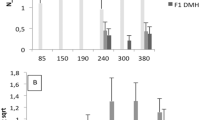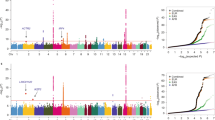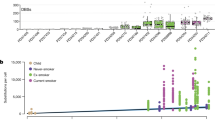Abstract
Lung tumours represent a major cause of death in humans, and although smoking represents the main pathogenetic factor, inheritance also plays a part. However, the identification of possible predisposing genetic factors is difficult, because of their low penetrance. We took advantage of murine strains that are genetically susceptible or resistant to lung tumour development, to map murine genes associated with susceptibility to lung carcinogenesis. An F2 population of urethan–treated A/J × C3H/He mice was scored with 83 genetic markers. A chromosome 6 distal region, spanning 35 centiMorgans, contained a major lung tumour susceptibility locus. No other chromosomal region was significantly associated with lung tumour development.
This is a preview of subscription content, access via your institution
Access options
Subscribe to this journal
Receive 12 print issues and online access
$209.00 per year
only $17.42 per issue
Buy this article
- Purchase on Springer Link
- Instant access to full article PDF
Prices may be subject to local taxes which are calculated during checkout
Similar content being viewed by others
References
Ooi, W.L., Elston, R.C., Chen, V.W., Bailey-Wilson, J.E. & Rothschild, H. Increased familial risk for lung cancer. J. natl. Cancer Inst. 76, 217–222 (1986).
Law, M.R. Genetic predisposition to lung cancer. Br. J. Cancer 61, 195–206 (1990).
Joishy, S.K., Cooper, R.A. & Rowley, P.T. Alveolar cell carcinoma in identical twins. Ann. Int. Med. 87, 447–450 (1977).
Paul, S.M., Bacharach, B. & Goepp, C. A genetic influence on alveolar cell carcinoma. J. Surg. Oncol. 36, 249–252 (1987).
Biran, H., Goldstein, J. & Cohen, Y. A cancer-prone kindred with four siblings afflicted by aggressive poorly differentiated bronchogenic carcinoma. Lung Cancer 7, 345–353 (1991).
Caporaso, N.E. et al. Lung cancer and the debrisoquine metabolic phenotype. J. natl. Cancer Inst. 82, 1264–1271 (1990).
Uematsu, F. et al. Association between restriction fragment length polymorphism of the human cytochrome P450IIE1 gene and susceptibility to lung cancer. Jpn. J. Cancer Res. 82, 254–256 (1991).
Shimkin, M.B. & Stoner, G.D. Lung tumors in mice: application to carcinogenesis bioassay. Adv. Cancer Res. 21, 1–58 (1975).
Malkinson, A.M. The genetic basis of susceptibility to lung tumors in mice. Toxicology 54, 241–271 (1989).
Dragani, T.A., Manenti, G. & Della Porta, G. Quantitative analysis of genetic susceptibility to liver and lung carcinogenesis in mice. Cancer Res. 51, 6299–6303 (1991).
Malkinson, A.M., Nesbitt, M.N. & Skamene, E. Susceptibility to urethan-induced pulmonary adenomas between A/J and C57BL/6J mice: Use of AXB and BXA recombinant inbred lines indicating a three-locus genetic model. J. natl. Cancer Inst. 75, 971–974 (1985).
Ryan, J., Barker, P.E., Nesbitt, M.N. & Ruddle, F.H. KRAS2 as a genetic marker for lung tumor susceptibility in inbred mice. J. natl. Cancer Inst. 79, 1351–1357 (1987).
Oomen, L.C., van der Valk, M.A. & Demant, P. MHC and non-MHC genes in lung tumor susceptibility in the mouse: implications for the study of the different lung tumortypes and their cell of origin. Exp. Lung Res. 17, 283–304 (1991).
Conover, W.J. & Iman, R.L. Rank transformations as a bridge between parametric and nonparametric statistics. Am. Statistician 35, 124–129 (1981).
Dietrich, W. et al. A genetic map of the mouse suitable for typing intraspecific crosses. Genetics 131, 423–447 (1992).
Hillyard, A.L., Doolittle, D.P., Davisson, M.T. & Roderick, T.H. Locus map of mouse with comparative map points of human on mouse (Jackson Laboratory, Bar Harbor, Maine, 1992).
Love, J.M., Knight, A.M., McAleer, M.A. & Todd, J.A. Towards construction of a high resolution map of the mouse genome using PCR analyzed microsatellites. Nucl. Acids Res. 18, 4123–4130 (1990).
Stowers, S.J., Glover, P.L., Reynolds, S.H., Boone, L.R., Maronpot, R.R. & Anderson, M.W. Activation of the K-ras protooncogene in lung tumors from rats and mice chronically exposed to tetranitromethane. Cancer Res. 47, 3212–3219 (1987).
You, M., Candrian, U., Maronpot, R.R., Stoner, G.D. & Anderson, M.W. Activation of the Ki-ras protooncogene in spontaneously occurring and chemically induced lung tumors of the strain A mouse. Proc. natn. Acad. Sci. U.S.A. 86, 3070–3074 (1989).
Devereux, T.R., Anderson, M.W., Belinsky, S.A. Role of ras protooncogene activation in the formation of spontaneous and nitrosamine-induced lung tumors in the resistant C3H mouse. Carcinogenesis 12, 299–303 (1991).
Re, F.C. et al. Multiple molecular alterations in mouse lung tumors. Molec. Carcinogenesis 5, 155–160 (1992).
You, M. et al. Parental bias of Ki-ras oncogenes detected in lung tumors from mouse hybrids. Proc. natn. Acad. Sci. U.S.A. 89, 5804–5808 (1992).
Wright, S. The genetics of quantitative variability. in Quantitative Inheritance (eds Reeve, E.C.R. & Waddington C.H.) 5–41 (HMSO, London, 1952).
Lander, E.S. & Botstein, D. Mapping mendelian factors underlying quantitative traits using RFLP linkage maps. Genetics 121, 185–199 (1989).
Avner, P., Amar, L., Dandolo, L. & Guenet, J.L. Genetic analysis of the mouse using interspecific crosses. Trends Genet. 4, 18–23 (1988).
Copeland, N.G. & Jenkins, N.A. Development and applications of a molecular genetic linkage map of the mouse genome. Trends Genet. 7, 113–118 (1991).
Weller, J.I., Soller, M. & Brody, T. Linkage analysis of quantitative traits in an interspecific cross of tomato (Lycopersicon esculentum × Lycopersicon pimpinellifolium) by means of genetic markers. Genetics 118, 329–339 (1988).
Paterson, A.M. et al. Mendelian factors underlying quantitative traits in tomato: comparison across species, generations, and environments. Genetics 127, 181–197 (1991).
Ponder, B.A.J. Inherited predisposition to cancer. Trends Genet. 6, 213–218 (1990).
Pierotti, M.A. & Dragani, T.A. Genetics and cancer. Cur. Opin. Oncol. 4, 127–133 (1992).
Nadeau, J.H. Maps of linkage and synteny homologies between mouse and man. Trends Genet. 5, 82–86 (1989).
Ryder-Cook, A.S. et al. Localization of the mdx mutation within the mouse distrophyn gene. EMBO J. 7, 3017–3021 (1988).
Lyon, M.F., Peters, J., Glenister, P.H., Ball, S. & Wright, E. The scurfy mouse mutant has previously unrecognized hematological abnormalities and resembles Wiskott-Aldrich syndrome. Proc. natn. Acad. Sci. U.S.A. 87, 2433–2437 (1990).
Travis, G.H. et al. The human retinal degeneration slow (RDS) gene: chromosome assignment and structure of the mRNA. Genomics 10, 733–739 (1991).
Su, L.K. et al. Multiple intestinal neoplasia caused by a mutation in the murine homolog of the APC gene. Science 256, 668–670 (1992).
Birrer, M.J. & Minna, J.D. Genetic changes in the pathogenesis of lung cancer. Ann. Rev. Med. 40, 305–317 (1989).
Malkinson, A.M. Primary lung tumors in mice: an experimental manipulate model of human adenocarcinoma. Cancer Res. 52, 2670s–2676s (1992).
SAS Institute Inc., SAS Users Guide: Statistics (SAS Institute, Gary, NC, 1988).
Lander, E.S. et al. Mapmaker: An interactive computer package for constructing primary genetic linkage maps of experimental and natural populations. Genomics 1, 174–181 (1987).
Author information
Authors and Affiliations
Rights and permissions
About this article
Cite this article
Gariboldi, M., Manenti, G., Canzian, F. et al. A major susceptibility locus to murine lung carcinogenesis maps on chromosome 6. Nat Genet 3, 132–136 (1993). https://doi.org/10.1038/ng0293-132
Received:
Accepted:
Issue Date:
DOI: https://doi.org/10.1038/ng0293-132
This article is cited by
-
A model for RAS mutation patterns in cancers: finding the sweet spot
Nature Reviews Cancer (2018)
-
The error-prone DNA polymerase ι provides quantitative resistance to lung tumorigenesis and mutagenesis in mice
Oncogene (2014)
-
Multigenic nature of the mouse pulmonary adenoma progression 1locus
BMC Genomics (2013)
-
SPECT/CT of lung nodules using 111In-DOTA-c(RGDfK) in a mouse lung carcinogenesis model
Annals of Nuclear Medicine (2013)
-
The Kras2 oncogene and mouse lung carcinogenesis
Medical Molecular Morphology (2008)



